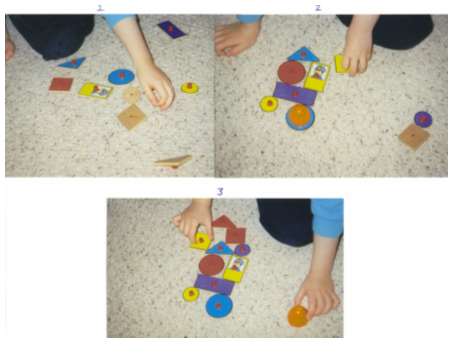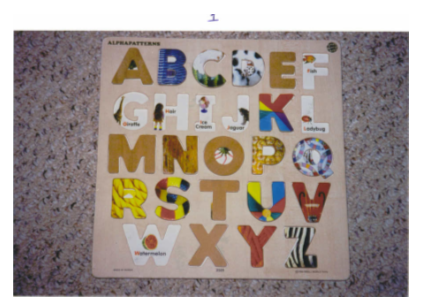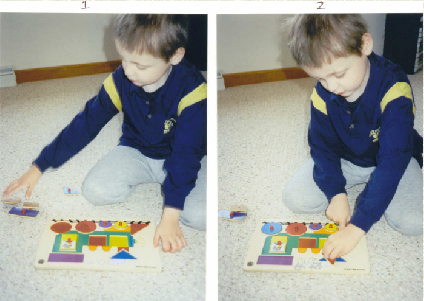Using Puzzles In A Nonsense Way
It was a well known fact that autistic children were usually fantastic at putting together puzzles. Given that putting a puzzle together involves the creation of a whole, I now understood why this was a preferred activity among these children. Putting a puzzle together allowed autistic children to do away with the "parts" and form a whole... to integrate the parts into a whole!
I decided to use puzzles to do the "unusual", to "break order"... to use them in a nonsense way to help Zachary deal with issues of partiality. I found this exercise particularly troubling for Zachary. Of course, in making a puzzle, each piece has a specific place. I have one puzzle in particular that worked well for this exercise. It was a train puzzle (see below). It had two big wheels (circles), two small wheels (circles), two cars (squares), etc. Each circle or square had a specific color and went in a corresponding colored place... at least that was how the puzzle had been "intended" to work. The particular puzzle I had was made by a company called Small World Toys. It was item number: 2547 and was called Loco Shapes. This company could be reached at 800-421-4153. I had purchased this puzzle through a local school supply store that provided multiple wooden puzzles. Any puzzle similar to this would work though.
The "colors" to the puzzle were supposed to be used to match the corresponding shape/color that fit into each part. That was the "normal" way in which this puzzle was supposed to be used. In dealing with issues of partiality and the "in between" situation, however, there were several things I could do with this simple puzzle to address Zachary's issues. :o)
Note: Right mouse click on the image below and select "View Image" to enlarge...make sure you read notes below pictures, too!

Obviously, putting all the pieces in the right place was no problem for Zachary. But, what drove him absolutely insane was the fact that I put the small purple circle where the small yellow circle should go, or the red square where the yellow square should go, or the large blue wheel where the large red wheel should go, or the red triangle where the blue triangle should go. I also put some pieces "upside down (i.e., the conductor), or I flipped a piece around (see square in center of puzzle in picture 2 above). As I worked with this puzzle, I started by only making one thing "odd" or out of place and started from there. This simple activity resulted in tremendously heightened stress levels for Zachary... much more so than any previous activity. I suspect the fact that colored pieces went in specific colored places had something to do with the intense stress level in Zachary. With the FractionStax, all stacks were white and so, they could more easily be moved around... but, with the train puzzle, each piece had a very specific place! This was by far the hardest exercise for Zachary to deal with! I have not done this one in a while since I have misplaced a couple of pieces but, once things settle down, I will be looking for those and pulling this one out again! I just hope that Zachary did not decide to throw some of them in the trash - perhaps a coping skill I may not have caught yet! :o)
To Zachary, the purple "wheel" went where the circle was colored purple on the wooden frame, the red square went where the square was colored red on the wooden frame... he absolutely could not tolerate the pieces being "mixed around" and not being "in their proper place".
In picture 3, Zachary "draws" something for me... in this case, he was attempting to make a "tractor". You can see that the little yellow circle, big red circle, conductor piece and purple rectangle, when taken together, do form a tractor. Once again, he had created a "new entity" to better be able to cope with the situation before him. He would tell me what he was "drawing" with the pieces. Usually, it started out looking like what he said he was making, but then, his need to "use all the pieces", all the parts to the whole, inevitably made it so that the object no longer resembled what he was trying to make at all. But, to me, that was ok... he was still using the pieces in a manner that increases his flexibility...rearranging them in several ways on the floor...using them in a manner in which they were not originally intended to be used... and that in itself was good too! There was still "flexibility" there in how he used objects... but, then, I always had that "new entity" in the back of my mind too and the fact that creating "new objects" from frustrating situations was also clearly a coping mechanism... but, I decided I would take things one step at a time. I understood the issues I had to deal with, and that made things a lot easier!
I worked with him on trying to use just "some" of the pieces as opposed to his having to always use "all of them"... again, it was always the "all or none" principle with Zachary. I took a few pieces away (here the blue triangle) to help him slowly learn to cope an "in between" situation. Zachary would still end up putting it back. Actually hiding a piece or two could also help with issues of partiality.
Ultimately, I wanted Zachary himself to be able to put puzzle pieces where they did not belong and be ok with that - even if some pieces were upside down, flipped over, etc... and to be able to "draw" things without having to use every single piece.

In the above, note how, again, I flipped some pieces over so that the "wood color" showed instead of the bright color on the face of the puzzle piece (see picture 1). Note that by picture 2, Zachary was already at work "flipping back" the pieces so that the bright side showed. Note also, that in picture 2 I added an orange "plastic egg shell half" on the large blue circle. Finally, by picture 3, note that all pieces are "flipped back"... but also notice that Zachary has removed the orange egg shell part... since it "did not belong"... it was not part of the whole.
When I see Zachary able to "leave the egg shell there", again, I will know he is making progress. To me, it was all a matter of allowing for "in between", "out of the ordinary" situations. I could pretty well do this type of exercise with any puzzle. I did the same type of thing with a wooden puzzle I had for the alphabet.

I left some pieces out on purpose and usually placed them somewhere on the carpet nearby so that Zachary could see them. He could not tolerate that - he wanted them "in place". It was always an "all or nothing". If I removed some of the alphabet after he had "put them where they belonged", he got very frustrated and threw the whole puzzle in the air...making all the pieces go flying. I would also turn letters around, so that he saw the back or "wood" instead of the color on the face of the letter. I could do that for letters like "A", "E", "M", "O", "S", "T", "W", "X", "Y", Z". Again, that drove him totally insane. But, I kept "mixing things up", "breaking order" - trying to increase his flexibility. To a normal child, this would be something "funny to do", and certainly, not that stressful. That was definitely not the case for Zachary. These puzzle exercises definitely "hit a nerve"! He needed a lot of understanding, hugging and verbal reinforcement when I did these things. I always said, "let's make it different", or "that's so silly"...but, still, this was a very difficult one for him...labeling things as "upside down" made them easier to deal with... more proof that order, labeling and partiality were key!
In April of 2002, I thought I had found the trick to helping Zachary with this whole "puzzle thing".
I was so thrilled... but, that would soon be short lived as I realized that again, the issue still had not been resolved.
I had put away Zachary's train puzzle for about 2 months. In late April of 2002, I pulled it out again. The same thing happened... if the pieces were out of place... he got very upset (not as much as he used to...but, still too much). So, I did not do much with him on that first day working on this again.
That day, I just thought about the best way to go about breaking his fanatic need for order when it came to these particular puzzle exercises! The next morning, I really thought I had figured it out!
Zachary has a good understanding of "broken" and "fix it"...so, I used those concepts. I took out the train, and said, let's make a "broken train". At first he resisted a little as I showed him a "broken train"... by putting the pieces in the wrong place. As I did this, I told him, "you can fix it later". Of course, the first time or two, he tried to put the pieces back where they belonged...as he did that, I said, "you fixed the broken train"...and he happily said " the green train is all fixed" (green is the primary color for this little engine puzzle).
I then asked him to "make me a broken train"... and he did! He was finally able to put pieces where they did not belong. If we used the words "broken train", he was fine with putting pieces in wrong places and then leaving them there and walking away.
I could now use the concept of "broken" to my advantage in helping to teach him flexibility. Phrases like "let's do it the "right" way" to have him place pieces in the appropriate color coded spot...then, "let's do it the "wrong" way to have pieces in places they did not belong (equivalent of the "broken train"). The next step would be to add "let's do it another way"... where some pieces were in the right place, and others were not. The introduction of "another way", in my opinion, would be key to so many things... once he understood that concept, I was sure flexibility would carry over into so many other things! I was very very excited about this.
Well, my joy was short lived on this one. As thrilled as I was to have Zachary make a "broken train" and see him finally be able to put the train puzzle pieces where they did not belong, I soon realized that again... this still was not an "in between" situation. It took me no time at all to realize that now, Zachary wanted to make the train either "all broken" - with no pieces in the right place - or "all fixed" - with all pieces going exactly where they belonged. I then tried to make it a "mixed up train" (some pieces in the right place, others out of place)... that did not go over so well. I have not done the "train puzzle" in a while as I have let him enjoy the summer while I worked on sharing these insights, but this will be one we tackle again soon. I knew we were almost there though! I think if I work on labeling it as "a mixed up train" then Zachary should be much better able to cope with the "in between situation". :o)
Sometimes stepping away from exercises and coming back to them a few weeks later, I found, was the better way to go... allowing me to look at something in a slightly different way the next time. Putting things away for a while was also less stressful and allows you time to get that new insight and at times, those new insights can open up so many more possibilities and opportunities for advancement. Finding the right label to teach everything and to minimize stress... that was indeed the challenge!
